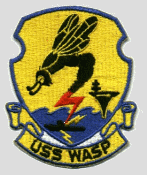
Contributed by Mike Smolinski
(Larger image (359Kb) contributed by Steve Connelly)

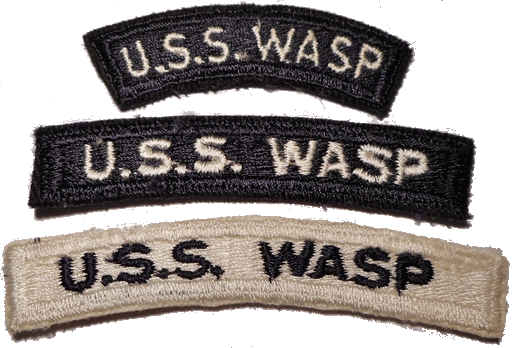
|
||||||




|
||||||
 |
||||||


|


|
|||||
Initially named Oriskany. Built by Bethlehem Quincy. Laid down 18 Mar 1942, renamed to honor CV-7 26 Sept 1942, launched 17 Aug 1943, commissioned 24 Nov 1943. Damaged by bombs off Kyushu 19 Mar 1945. Decommissioned to reserve 17 Feb 1947.
SCB 27A reconstruction at New York Navy Yard started 9/1948, completed and recommissioned 28 Sept 1951. Redesignated as an attack carrier (CVA 18) 1 October 1952. SCB 125 angled deck modernization at San Francisco Navy 3/1955 to 1 Dec 1955. Redesignated as an ASW carrier (CVS 18) 1 Nov 1956. FRAM II life extension 1963–64.
FATE
Decommissioned and stricken for disposal 1 July 1972. Sold to Union Minerals & Allys Corp.,
NYC, 21 May 1973. Scrapped in Kearny, NJ, by Lipsett Div. of Luria Brothers, NYC.
| Click On Image
For Full Size Image |
Size | Image Description | Contributed
By And/Or Copyright |
|||||||||||||||||||||
|---|---|---|---|---|---|---|---|---|---|---|---|---|---|---|---|---|---|---|---|---|---|---|---|---|
| Name |
||||||||||||||||||||||||
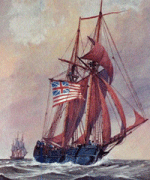 NS098680001 |
30k | CV-18, initially named Oriskany, was renamed Wasp on 26 September 1942, to honor CV-7, lost in action eleven days earlier. (The name Oriskany was subsequently assigned to CV-34.) A wasp is any of numerous winged hymenopterus insects possessing smooth, slender bodies, and an abdomen attached by a narrow stalk. They have well developed wings, biting mouthparts, and often administer painful stings. Eight American warships had previously borne the name:
NS098680001: The first Wasp under sail. Note the Grand Union Flag. (Image submitted by Robert Hurst.) NS020740: A wasp is any insect of the order Hymenoptera and suborder Apocrita that is neither a bee nor an ant. Wasps often administer painful stings. (Vespula germanica, photo by Richard Bartz.) |
NavSource | |||||||||||||||||||||
 NS020740 |
117k | |||||||||||||||||||||||
| The Early Years — World War II |
||||||||||||||||||||||||
NS021877 |
531k | USS Wasp (CV-18), World War II. Overhead plan and starboard profile meticulously drawn by John Robert Barrett. |
Navy Yard Associates | |||||||||||||||||||||
 NS021823 |
107k | Ready for launching, at the Bethlehem Steel Company shipyard, Quincy, Massachusetts, 17 August 1943. Official U.S. Navy Photograph, now in the collections of the National Archives (Photo #: 80-G-K-14048). |
Scott Dyben | |||||||||||||||||||||
 NS021823a |
121k | Launching, Bethlehem Steel Company shipyard, Quincy, Massachusetts, 17 August 1943. |
Steve Whitby | |||||||||||||||||||||
 NS021823b |
382k | This group of officers had just received a promotion and attended the launching ceremony of Wasp (CV-18). They are identified as (left to right): (LT(JG)) Katzenstein, (CDR) Leahey, (LT) Kintzel, (LCDR Fred M.) Larson, (LT) Baldwin, (LT(MC)) Edgerly, (?) Chaleston, (LCDR(MC)) Foley, (?) Funston, and (LT R.D.) Taylor. NS021823c: Memorandum for the Captain of USS Iowa (BB-61), dated the day before, 16 August 1943. |
Christopher Larson, grandnephew of Fred M. Larson | |||||||||||||||||||||
 NS021823c |
88k | |||||||||||||||||||||||
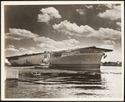 NS021823d |
809k | The future USS Wasp (CV-18) water borne, Quincy, Massachusetts, Tuesday, 17 August 1943. National Archives and Records Administration (NARA) photo, Record Group 181, identifier 38330007. |
NARA, via Michael Mohl | |||||||||||||||||||||
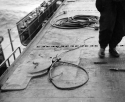 NS0218az |
520k | USS Wasp (CV-18), No.3 starboard deck sheave on board from which pendant pulled free, prior to replacement. Photograph released 18 January 1944. Official U.S. Navy photograph, now in the collections of the National Archives and Records Administration (NARA), # 80-G-221116. |
NARA | |||||||||||||||||||||
 NS0549602 |
157k | USS McCook (DD-496) alongside USS Wasp (CV-18), 13 February 1944. Official U.S. Navy photograph, now in the collections of the National Archives and Records Administration (NARA), # 80-G-221123. |
Captain Jerry Mason, USN | |||||||||||||||||||||
 NS021818 |
89k | Underway at sea in the vicinity of Trinidad, with planes parked forward, apparently in preparation for landing aircraft, 22 February 1944. Official U.S. Navy Photograph, now in the collections of the National Archives (Photo #: 80-G-221142). |
Scott Dyben | |||||||||||||||||||||
 NS021818b |
580k | "U.S.S. Wasp, 27,100 ton Aircraft Carrier, length 855'10" sp.30 knots. Main Battery 12-5"/38. Aircraft 90. Crew 2500." This photo appears to have been taken at approximately the same time as the one above. |
Jim Kurrasch, Battleship Iowa, Pacific Battleship Center | |||||||||||||||||||||
 NS021818a |
215k | Another view, similar to the ones above. US Navy and Marine Corps Museum/Naval Aviation Museum (NNAM) photo # 1996.488.053.032. Robert L. Lawson Photograph Collection. |
Mike Green | |||||||||||||||||||||
 NS021832 |
85k | Boston Navy Yard, March 14, 1944. Wasp is believed to have been the first carrier camouflaged in Measure 33, Design 10A. |
Steve Whitby | |||||||||||||||||||||
 NS021833 |
85k | As above. Good port side view of Measure 33, Design 10A. |
Steve Whitby | |||||||||||||||||||||
NS021876 |
49k | Starboard side view of the aircraft carrier USS Wasp (CV-18) in March 1944 wearing Measure 32/10A camouflage. It may be observed that Wasp had a 40 mm quad mount forward of the island, as well as four deck-edge radio masts. USN Photo. Photo and text from "Aircraft Carriers of the U.S. Navy," by Stefan Terzibaschitsch. |
Robert Hurst | |||||||||||||||||||||
 NS021834 |
195k | A TBM-1C Avenger from VT-14 early in Wasp's combat career (no markings on the tail), June 1944, ends up in the water after a failed cat shot. |
Steve Whitby | |||||||||||||||||||||
 NS021835 |
195k | |||||||||||||||||||||||
 NS0218ak |
161k | Damaged engine of an F6F-3 Hellcat (BuNo 41972) after crashing into island structure aboard USS Wasp (CV-18), 2 June 1944. U.S. Navy photograph, now in the collections of the National Archives and Records Administration (NARA), # 80-G-266350. |
NARA | |||||||||||||||||||||
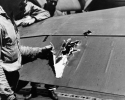 NS0218ba |
649k | Damage to port elevator of an SB2C-3 Helldiver (Bu# 19186), seen on the flight deck of USS Wasp (CV-18), 4 July 1944, after an Iwo Jima raid, H.J. Skagges, USNR, Pilot. (This aircraft was lost on 14 September 1944, off Los Negros, Philippine Islands. Pilot was ENS Reardon.) U.S. Navy photograph, now in the collections of the National Archives and Records Administration (NARA), # 80-G-266364. |
NARA | |||||||||||||||||||||
 NS0218au |
659k | USS Wasp (CV-18), 7 July 1944. Rear Admiral Ralph Davidson presenting the Purple Heart to personnel aboard the carrier. Shown: ARM2 Richard J. Lyman, USN. U.S. Navy photograph, now in the collections of the National Archives and Records Administration (NARA), # 80-G-266354. |
NARA | |||||||||||||||||||||
 NS0218aua |
650k | USS Wasp (CV-18), 7 July 1944. Rear Admiral Ralph Davidson presenting the Purple Heart to personnel aboard the carrier. Shown: ARM2 Richard J. Lyman, USN. U.S. Navy photograph, now in the collections of the National Archives and Records Administration (NARA), # 80-G-266358. |
NARA | |||||||||||||||||||||
 NS021836 |
136k | SB2C-1C Helldiver from VB-14 collides with one of Wasp's 5" gun mounts returning from a raid on Palau, August 1944. |
Steve Whitby | |||||||||||||||||||||
 NS021837 |
147k | This SB2C Helldiver from VB-14 ended up "in the drink" after a bad landing, August 1944. |
Steve Whitby | |||||||||||||||||||||
 NS021819 |
89k | Flight deck crews prepare to load a Mark XIII torpedo on a TBM aircraft, during strikes in the Luzon-Formosa area, 13 October 1944. Note plywood shrouds on the torpedo's fins and nose. Plane at right is an F6F, others visible are TBMs. Official U.S. Navy Photograph, now in the collections of the National Archives (Photo #: 80-G-298609). |
Scott Dyben | |||||||||||||||||||||
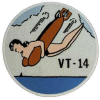 NS021895 |
15k | Torpedo Squadron (VT) 14, part of Carrier Air Group (CVG) 14, was established in August 1943 and assigned to Wasp (then still under construction); commissioned in September; Wasp commissioned in November 1943, and VT-14 was aboard until early November 1944. During this time the squadron was awarded a Navy Unit Commendation and four "Battle Stars." |
Tommy Trampp | |||||||||||||||||||||
 NS021820 |
78k | Third Fleet aircraft carriers at anchor in Ulithi Atoll, 8 December 1944, during a break from operations in the Philippines area. The carriers are (from front to back): USS Wasp (CV-18), USS Yorktown (CV-10), USS Hornet (CV-12), USS Hancock (CV-19) and USS Ticonderoga (CV-14). Wasp, Yorktown and Ticonderoga are all painted in camouflage Measure 33, Design 10a. Photographed from a USS Ticonderoga plane. Official U.S. Navy Photograph, now in the collections of the National Archives (Photo #: 80-G-294131). |
Scott Dyben | |||||||||||||||||||||
 NS021820a |
135k | Another view, as above. National Archives photo (# 80-G-294129). |
Gerd Matthes, Germany | |||||||||||||||||||||
 NS021807 |
78k | December 11, 1944 photo of the Wasp at sea. | USN | |||||||||||||||||||||
 NS021874 |
93k | "Island structure of the (USS Wasp) as seen from the bow with battery of 5" guns in the foreground." 23 December 1944. Photographer: T4 Thomas Kane. U.S. Army Signal Corps photo (SWPA-SigC-45-958). U.S. National Archives (SC 265315). |
Dave Kerr | |||||||||||||||||||||
 NS021874a |
89k | "A crew chief gives visual taxiing instructions to a pilot who has just landed on the (USS Wasp in Central Pacific) waters, helping thim to clear the way for another incoming planes." 23 December 1944. Photographer: T4 Thomas Kane. U.S. Army Signal Corps photo (SWPA-SigC-45-961). U.S. National Archives (SC 265317). |
Dave Kerr | |||||||||||||||||||||
 NS021874b |
83k | "Plane from the (USS Wasp, cruising in Central Pacific) waters, takes off for combat patrol." 23 December 1944. Photographer: T4 Thomas Kane. U.S. Army Signal Corps photo (SWPA-SigC-45-964). U.S. National Archives (SC 265320). |
Dave Kerr | |||||||||||||||||||||
 NS021875 |
107k | "Planes of the (USS Wasp), with wings folded, secured on the flight deck between combat patrols." 24 December 1944. Photographer: T4 Thomas Kane. U.S. Army Signal Corps photo (SWPA-SigC-45-960). U.S. National Archives (SC 265316). |
Dave Kerr | |||||||||||||||||||||
 NS021875a |
87k | "Blinding flashes of sulphur colored flames, and earsplitting detonations from the firing of a battery of twin five inch guns, keynotes sleeve target practice aboard the (USS Wasp)." 24 December 1944. Photographer: T4 Thomas Kane. U.S. Army Signal Corps photo (SWPA-SigC-45-962). U.S. National Archives (SC 265318). |
Dave Kerr | |||||||||||||||||||||
 NS021875b |
111k | "To clear the flight deck of damaged planes, large elevators operate between decks; center elevator is shown taking a plane below." 24 December 1944. Photographer: T4 Thomas Kane. U.S. Army Signal Corps photo (SWPA-SigC-45-963). U.S. National Archives (SC 265319). |
Dave Kerr | |||||||||||||||||||||
 NS0218bc |
69k | Marty notes: "My Grandfather, Edward M. Lonergan, was the oldest crew member aboard the USS Wasp (CV-18). Attached is a photo of him and his crew mates on deck in 44–45." |
Marty Lonergan | |||||||||||||||||||||
 NS021882 |
73k | A U.S. Navy Curtiss SB2C-4 Helldiver of Bombing Squadron (VB) 86 in the landing pattern over the aircraft carrier USS Wasp (CV-18), in 1945. |
Tommy Trampp | |||||||||||||||||||||
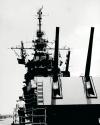 NS0218ax |
267k | Looking aft, a view of a forward twin 5"/38 gun mount aboard USS Wasp (CV-18), in 1945. National Naval Aviation Museum photo # 1977.031.074.017. |
Mike Green | |||||||||||||||||||||
 NS021824 |
154k | A really unique shot taken from the catwalk under the bow of the 40-mm gun crew and the Mk.51 director for that gun. January 1945. National Archives. | Steve Whitby | |||||||||||||||||||||
 NS021838 |
80k | USS Wasp in late January 1945, being refueled by USS Chipola (AO-63). Note the early flag bridge with lower quad 40mm's and the hangar deck catapult. |
Steve Whitby | |||||||||||||||||||||
 NS021839 |
77k | USS Wasp at Ulithi, February 1945, airing her laundry from the hangar deck. |
Steve Whitby | |||||||||||||||||||||
 NS021840 |
138k | Two interesting pictures of the USMC detachment. Top: Circa April 1945. Note the "early bridge" with the forward quad 40mm gun tub on the island and her dazzle paint. Bottom: At some later time. Same spot, after island had been modified and the ship repainted in a new camouflage scheme. |
Steve Whitby | |||||||||||||||||||||
 NS021841 |
121k | |||||||||||||||||||||||
 NS021800 |
91k | Official photo of USS Wasp (CV-18) during World War II. Undated, but probably taken just after her April–June 1945 repair-refit, as the photos below. Note there are only two radio masts, two quad 40-mm gun mounts in a sponson (port, forward), and two aft. Photo by pilot LT(JG) Grasen. |
Tommy Trampp Larger photo submitted by David Buell |
|||||||||||||||||||||
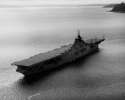 NS0218aq |
541k | USS Wasp (CV-18). Undated, but probably taken after her April–June 1945 repair-refit, as the photos below. Note two quad 40-mm gun mounts aft, three amidships; two radio masts. |
David Buell | |||||||||||||||||||||
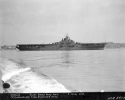 NS021858c |
467k | Broadside view, starboard side, USS Wasp (CV-18), 2 June 1945. Puget Sound Navy Yard photo (# 2798-45). |
David Buell | |||||||||||||||||||||
 NS021858a |
107k | Bow view, port side, of USS Wasp (CV-18), 2 June 1945. Puget Sound Navy Yard photo (# 2799-45). US Navy and Marine Corps Museum/Naval Aviation Museum, photo # 1996.488.053.037. Robert L. Lawson Photograph Collection. |
Mike Green | |||||||||||||||||||||
 NS021858b |
119k | Head on view of USS Wasp (CV-18), 2 June 1945. Puget Sound Navy Yard photo (# 2802-45). US Navy and Marine Corps Museum/Naval Aviation Museum, photo # 1996.488.053.038. Robert L. Lawson Photograph Collection. |
Mike Green | |||||||||||||||||||||
 NS021858 |
90k | Stern view, port side, of USS Wasp (CV-18). June 2, 1945. Puget Sound Navy Yard photo (# 2803-45). |
Original copy submitted by Tracy White, Researcher @ Large. Larger copy courtesy of Scott Koen & ussnewyork.com |
|||||||||||||||||||||
NS021878 |
48k | Portside view of the aircraft carrier USS Wasp (CV-18) in June 1945 once more painted to Measure 21. The usual disposition of the 40 mm AA at that time is visible: one quad forward of the island has been removed, three more are fitted on the starboard side, and those furher aft are moved forward. There are only two deck-edge masts now. USN Photo. Photo and text from "Aircraft Carriers of the U.S. Navy," by Stefan Terzibaschitsch. |
Robert Hurst | |||||||||||||||||||||
 NS021879 |
126k | USS Wasp (CV-18) at anchor on 9 June 1945, out of Puget Sound. Note the Mk-51 Mod 2 radar on the port side of the bow quad mounting—an arrangement which obstructed controlled firing to starboard. Beginning with Wasp, the Mk-51 was no longer fitted on a separate control pedestal between the island and the second forward 5/38 turret, but on the island itself. On some ships the identification number on the forward flight deck, which was always painted in a dark colour, was orientated to be read from the front. This caused some misunderstandings, especially when an escort carrier with the number 81 [USS Rudyerd Bay] entered the fleet, and these forward deck numbers were later reversed. Radar and electronica at this time consisted of: Radar SK, SP. Fire control: 2 Mk-37 directors with radar Mk-12/22 and 2 Mk-51 Mod 2 (for 5"); also 4 Mk-63 directors with radar Mk-28, 2 Mk-57 directors with radar Mk-29 and 12 Mk-51 (for 40 mm). Photo and text from "Aircraft Carriers of the U.S. Navy," by Stefan Terzibaschitsch. |
Robert Hurst | |||||||||||||||||||||
 NS021879a |
123k | Broad on starboard bow view of USS Wasp (CV-18). 9 June 1945. Puget Sound Navy Yard photo. |
Courtesy of Scott Koen & ussnewyork.com | |||||||||||||||||||||
 NS021879b |
157k | Broad on, port beam, of USS Wasp (CV-18), 9 June 1945. Puget Sound Navy Yard photo. US Navy and Marine Corps Museum/Naval Aviation Museum, photo # 1996.488.053.042. Robert L. Lawson Photograph Collection. |
Mike Green | |||||||||||||||||||||
 NS021879c |
143k | Dead ahead view of USS Wasp (CV-18), 9 June 1945. Puget Sound Navy Yard photo. US Navy and Marine Corps Museum/Naval Aviation Museum, photo # 1996.488.053.047. Robert L. Lawson Photograph Collection. |
||||||||||||||||||||||
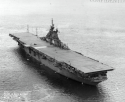 NS021879d |
539k | Broad on port quarter view of USS Wasp (CV-18), 9 June 1945. Puget Sound Navy Yard photo. |
David Buell | |||||||||||||||||||||
 NS021879e |
380k | Possibly another view as above. |
||||||||||||||||||||||
 NS021842 |
157k | Wasp had her hull number painted upside down on the forward part of the flight deck for some reason. Hornet also started out this way but someone with a little authority thought it looked stupid and had it painted right side up shortly after entering combat. Although this photo is undated, it must have been taken in June 1945 or later, as Wasp didn't have the port catapult until then. (Thanks to Tracy White, who pointed this out). |
Steve Whitby | |||||||||||||||||||||
 NS021843 |
151k | One of Wasp's F4U-1D's from VBF-86 does a flip onto an SB2C-4, July 1945. |
Steve Whitby | |||||||||||||||||||||
 NS021844 |
91k | Photo taken from Wasp's island looking aft over her 40mm's and 5" DP guns showing her airgroup, August 1945. |
Steve Whitby | |||||||||||||||||||||
 NS021801 |
112k | At sea in the western Pacific, 6 August 1945. Official U.S. Navy Photograph, now in the collections of the National Archives (Photo #: 80-G-261904). |
Scott Dyben | |||||||||||||||||||||
 NS021845 |
94k | Carrier Operations off Japan, August 1945 — A Japanese aircraft is shot down just off the starboard bow of USS Wasp (CV-18), during operations off Honshu, Japan, 9 August 1945. Two Fletcher-class destroyers are in the foreground. Photographed from USS Bon Homme Richard (CV-31), the image includes two frames, showing the scene just before and after the crash. The original caption identifies the aircraft as a Grace (Aichi B7A2). Official U.S. Navy Photograph, now in the collections of the National Archives (# 80-G-455702). |
NHC | |||||||||||||||||||||
 NS021887 |
138k | A Royal Navy T-class destroyer steams next to the U.S. aircraft carrier USS Wasp (CV-18) in August 1945. The destroyer's pennant number is obscured (D4?). Five T-class destroyers and the carrier HMS Indefatigable (R10) were part of Task Group 38.3 in August 1945: HMS Teazer (D45), HMS Tenacious (D46), HMS Termagant (D47), HMS Terpsichore (D48), and HMS Troubridge (D49). The two funnel rings identify the ship as part of the 24th destroyer flotilla (all T-class destroyers). As the vertical stripe identifies the division leader in the flotilla (the second senior commander), the destroyer is most probably Terpsichore. In the distance are a long-hull Essex-class carrier, probably USS Randolph (CV-15)—flagship for RADM Gerald F. Bogan—, and the battleship USS North Carolina (BB-55). U.S. Navy National Museum of Naval Aviation photo No. 1977.031.074.099. This image is part of a photograph album that was acquired by RADM Joseph C. Clifton during his service as Executive Officer of Wasp during World War II. |
Robert Hurst | |||||||||||||||||||||
 NS021821 |
500k | Task Force 38, of the U.S. Third Fleet, maneuvering off the coast of Japan, 17 August 1945, two days after Japan agreed to surrender. Taken by a USS Shangri-La (CV-38) photographer. The aircraft carrier in lower right is USS Wasp (CV-18). The other identifiable carrier is Shangri-La in the left center. Also present in the formation are four other Essex-class carriers, four light carriers, at least three battleships (two of the Iowa class and one of the South Dakota class), plus several cruisers and destroyers. Official U.S. Navy Photograph, now in the collections of the National Archives and Records Administration (NARA), photo # 80-G-278815. |
Scott Dyben Robert Hurst |
|||||||||||||||||||||
 NS0218be |
1.44M | "VICTORY, V-J DAY, SPECIAL ISSUE, U.S.S. WASP PRESS" |
Steve Hatchett, for his father, LT(JG) George L. Hatchett, USN | |||||||||||||||||||||
 NS021846 |
148k | Like Hornet (CV-12) and Bennington (CV-20), Wasp had her flight deck smashed, too, but two months later, after the war was over, in a typhoon on August 26th, 1945. |
Steve Whitby | |||||||||||||||||||||
 NS021847 |
89k | |||||||||||||||||||||||
 NS021848 |
92k | Wasp's scoreboard on the forward bulkhead, hangar deck level just behind the forecastle. It reads left to right, "Enemy bases attacked, 36 islands / Major cities attacked, Tokyo, Saigon, Manila, Camranh Bay, Hong Kong, Canton, Kure // Aircraft destroyed in the air by ship's gunfire and AirGroup 14, AirGroup 81 and AirGroup 86, 230 / AirGroup 14, AirGroup 81 and AirGroup 86, Aircraft Destroyed on ground, 405 // Ships sunk, 114 / Ships damaged, 234." |
Steve Whitby | |||||||||||||||||||||
NS021871 |
344k | V Division aboard USS Wasp (CV-18) during WW II. The only two identified are A.J. "Lucky" Lewis and his best friend Edmund "Ski" Kotoski, both kneeling on second row on left side. David Long comments: "8th Sailor from the right, bottom row, kneeling is Seaman James C. Long, my father." Chip Lawson comments: "My Dad, Talmadge Lawson, was a gunner on board the Wasp. He is located on the third row from the bottom and 16th from the left." Jason D. Kosior believes that his grandfather, Florian "Floyd" Kosior, is in the bottom row, third from the left (as you look at the photo). "Iíve consulted with the family and we feel that this is his picture." "Floyd" Kosior "was a painter and was on the Wasp from November 24th 1943–September 15th 1945 and his rate was PtrV1c." |
Jim Lewis, son of Alfred J. Lewis | |||||||||||||||||||||
|
||||||||||||||||||||||||
 NS0218ac |
13.7M | The Aircraft Carrier USS Wasp CV-18, World War II Cruise Book. This copy of the book was owned by Florian "Floyd" Kosior, who served aboard Wasp, November 1943–September 1945. |
Jason D. Kosior, grandson of Florian "Floyd" Kosior | |||||||||||||||||||||
 NS0218aca |
14.6M | USS WASP CV-18 HISTORY, 24 November 1943–2 September 1945, The Seventh Wasp. |
Jim Lewis, son of Alfred J. Lewis | |||||||||||||||||||||
|
||||||||||||||||||||||||
| Crew Contact Information | ||||||||||||||||
|
| Main Photo Index |
Aircraft Carrier Photo Index Page |
Comments, Suggestions or Image submissions, E-mail Carrier Information
Problems and site related matters, E-mail Webmaster
This page was created by Paul Yarnall and is maintained by Fabio Peña
![]()
Last update: 13 October 2023